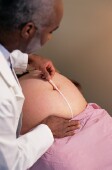
WEDNESDAY, June 20 (HealthDay News) — The teen pregnancy rate in the United States dipped to its lowest recorded level since 1976, a new government report shows.
Teen pregnancy rates fell 40 percent from 1990 to 2008, the latest year for which complete data are available, according to the U.S. National Center for Health Statistics.
The report, which details pregnancy rates for 2006 to 2008 for U.S. women aged 15 to 44, also found pregnancy rates were declining among women in their 20s and increasing among women in their 30s and 40s.
Overall, there was a total of 4,248,000 live births, 1,212,000 induced abortions and 1,118,000 fetal losses in 2008. The estimated pregnancy rate for 2008 was 105.5 pregnancies per 1,000 women aged 15 to 44, which is about 9 percent below the 1990 peak, the new report showed.
The U.S. teen pregnancy rate declined continuously during this time period, except for a brief upturn from 2005 to 2006. This decline was more pronounced in younger teens. The pregnancy rate for teens aged 15 to 17 declined by almost one-half from 1990 to 2008, while the rate for older teenagers declined by about one-third over this time period.
Some racial and ethnic gaps in teen pregnancy rates exist. In 2008, pregnancy rates for black and Hispanic teenagers aged 15 to 19 were two to three times higher than the rates for white teenagers.
The overall decline in teen pregnancy seems to be continuing. The researchers report that more recent birth data for teenagers show that the birth rate has continued to fall from 2008 through 2010.
So what is driving these trends? “The overall fertility has dropped a good bit in this country, and pregnancy rates are also going down, presumably because people are more careful about contraception,” said Dr. John Santelli, a pediatrician and adolescent medicine specialist who is the chair of the Heilbrunn Department of Population and Family Health at Columbia University’s College of Physicians and Surgeons, in New York City.
“Women are increasingly delaying childbearing into their late 20s, 30s and sometime even their 40s, which will lower the rates right there,” he said. The reasons are twofold: Some women are pursuing careers and the contraceptive use has also improved.
There have been pretty consistent declines in the teen birth rate and teen pregnancy rates since 1990. “This is good news,” Santelli said.
Media coverage of pregnant teens such as Bristol Palin and the advent of reality shows focusing on teen moms had left many public health experts concerned about the glamorization of teen pregnancy and its potential implications. But these events have had little bearing on the trends so far, he said.
“Bristol Palin standing up for abstinence is not what is going on here,” Santelli said. Instead, “this is probably related to better contraceptive use, including some of these newer methods such as long-acting reversible contraceptive methods and access to care.”
While 2008 data might already seem outdated in 2012, Santelli explained that it takes a while for states to accrue the information needed to analyze these trends. “Birth rates are pretty fast these days, but abortion reporting can be sluggish, which is why this 2008 data just became available.”
The decline in teen pregnancy rates overall is impressive, but gaps by race remain, said Dr. Jill Maura Rabin, an obstetrician/gynecologist at Long Island Jewish Medical Center-North Shore-LIJ Health System in Manhasset, N.Y.
“We know that support is what works best for teens — especially when they are pregnant,” she said. A support network made up of a nurse or other health care provider and a social worker is the best way to prevent a second pregnancy among teens. “It may be that certain teens need more support. We still have a lot of work to do.”
Rabin said that pregnancy and birth rates are declining among women in their 20s because of access to emergency contraception and more contraceptive choices including long-acting reversible contraception. “We have better education about these options,” she said. “Women are postponing starting a family because of the economy, they want to get their degrees and life expectancy is increasing.”
These same women may be more likely to consider getting pregnant in their 30s and 40s due to advances in reproductive endocrinology. “Our toolbox and skills have increased, and we are helping them get pregnant into their 40s,” she said. While some older women may have a difficult time getting pregnant, unplanned pregnancy can, and does, occur in this age group, she said.
“Women in the 40s think they can’t get pregnant anymore and have unprotected intercourse, but they can,” Rabin said. “If you are having intercourse and don’t want to be pregnant, use contraception.”
There are risks associated with pregnancy at older ages, she added. “Genetic issues increase as eggs age, but we have better testing for genetic disorders today,” Rabin said. “Older women are also more likely to develop pregnancy-related complications, but good prenatal care can help identify these conditions early and monitor women so that they have a healthy pregnancy.”
More information
Learn about
teen pregnancy, contraception and sexual health at the Guttmacher Institute.

